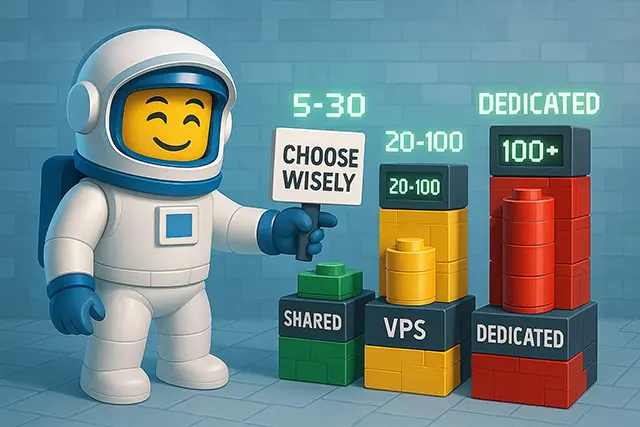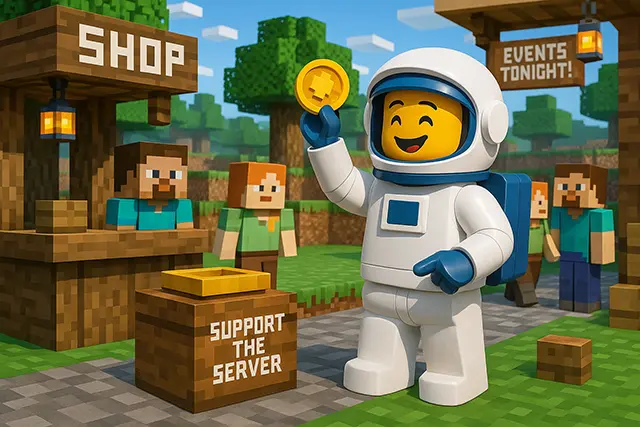Minecraft Server Hosting That Actually Works: What Most Gamers Overlook

Last week, my buddy Jake texted me at 2 AM. His Minecraft server was dead. Again. Forty players had just rage-quit after the third crash that night, and his carefully built community was falling apart. The worst part? He’d been paying $60 a month for “premium” hosting that couldn’t handle half the load it promised.
Here’s the thing about minecraft server hosting that nobody tells you upfront: picking the wrong provider isn’t just about wasted money. I’ve watched entire communities dissolve because admins chose hosting based on flashy marketing instead of actual performance. Jake’s story isn’t unique scroll through any Minecraft forum and you’ll find dozens of similar disasters.
After helping set up over 50 servers for various communities, I’ve learned that success comes down to matching your actual needs with the right hosting type. Not what some sales page claims you need, but what your specific situation actually requires. And yeah, there’s a massive difference.
Table of Contents
Why Your Home Computer Isn’t Cutting It Anymore
Let’s address the elephant in the room, Yes, you can technically host a Minecraft server from your gaming rig. But should you? The short answer is no, and here’s why. Modern Minecraft, especially with mods and resource packs, demands consistent performance that most home setups simply can’t deliver 24/7.
When you host from home, you’re not just sharing your computer’s resources you’re also exposing your personal IP address, dealing with residential internet limitations, and keeping your PC running constantly. That fancy RTX 4090 might handle single-player beautifully, but add ten players exploring different chunks simultaneously, and watch your frame rate plummet while your electricity bill soars.
Professional minecraft server hosting solves these problems by providing dedicated resources, enterprise-grade internet connections, and round-the-clock uptime. More importantly, it separates your gaming experience from your hosting responsibilities, letting you actually enjoy the game you’re paying to run.
The Real Cost of Free Minecraft Server Hosting
Before we dive into paid options, let’s talk about free minecraft server hosting because who doesn’t love free stuff? Services like Aternos and Minehut have attracted millions of users with their zero-cost promise, but there’s always a catch.
Free hosts typically limit you to minimal RAM (usually 1-2GB), restrict player slots, and force your server to shut down after periods of inactivity. Worse, they often display advertisements, limit plugin options, and provide zero customer support when things go wrong. That “free” server suddenly becomes expensive when you factor in the time lost to crashes, the players who leave due to poor performance, and the features you can’t access without upgrading.
That said, free hosting can work for specific scenarios. Testing plugin configurations, learning server administration, or running tiny private worlds for two or three friends might justify the limitations. Just don’t expect to build a community or run anything beyond vanilla gameplay smoothly.

Understanding Your Hosting Options: The Big Three
When it comes to paid minecraft server hosting, you’ll encounter three main categories: shared hosting, VPS (Virtual Private Server), and dedicated servers. Each serves different needs and budgets, so understanding the distinctions is crucial.
Quick Comparison: Hosting Types at a Glance
| Hosting Type | Best For | Player Capacity | Monthly Cost | Technical Skill Required |
|---|---|---|---|---|
| Shared Hosting | Beginners, small friend groups | 5-30 players | $5-25 | Minimal |
| VPS | Growing communities, modded servers | 20-100 players | $20-80 | Moderate |
| Dedicated | Large networks, multiple game modes | 100+ players | $100-500+ | Advanced |
| Free Hosting | Testing, learning basics | 2-10 players | $0 | Minimal |
Shared Hosting: The Budget-Friendly Starting Point
Shared hosting places your Minecraft server on a machine with dozens or hundreds of other servers. Think of it like living in an apartment building you have your own space, but you’re sharing the foundation, utilities, and resources with neighbors.
For small servers with 5-20 players running vanilla or lightly modded gameplay, shared hosting often provides the best value. Reputable providers allocate guaranteed resources, meaning your 4GB of RAM is actually yours, not theoretical. However, performance can vary based on what your “neighbors” are doing, and customization options remain limited.
The sweet spot for shared hosting lies in its simplicity. Most providers offer one-click installation, automatic updates, and preconfigured settings that get you running in minutes. If you’re new to server administration or just want to play with friends without the technical hassle, shared hosting delivers exactly what you need.
VPS Hosting: The Flexible Middle Ground
A VPS for minecraft server hosting represents the goldilocks zone for most serious server owners. You get a virtualized server with dedicated resources, root access for complete customization, and the ability to run multiple game servers or other applications alongside Minecraft.
The beauty of VPS hosting lies in its scalability. Start with 4GB of RAM and two CPU cores, then upgrade as your player base grows. Need to install custom Java versions, run specific Linux distributions, or implement complex backup solutions? A VPS gives you that freedom without the cost of dedicated hardware.
Many consider VPS hosting the best vps for minecraft server hosting because it balances performance, price, and flexibility. You’re essentially renting a portion of a powerful server, getting near-dedicated performance at a fraction of the cost. For servers with 20-100 players, modded gameplay, or multiple game modes, VPS hosting typically offers the best return on investment.
Dedicated Servers: Maximum Power, Maximum Control
When your Minecraft empire grows beyond what VPS can handle, dedicated servers become necessary. You’re renting an entire physical machine, meaning every bit of RAM, every CPU cycle, and every megabyte of SSD storage belongs exclusively to your Minecraft world.
Dedicated servers make sense for large networks running multiple game modes, servers pushing 100+ concurrent players, or projects requiring specific hardware configurations. The raw power eliminates any question about performance, but the complexity and cost increase proportionally.
Managing a dedicated server requires significant technical knowledge or hired help. You’re responsible for operating system updates, security patches, and hardware monitoring. While many providers offer managed dedicated servers with support included, expect to pay premium prices for that convenience.
Java vs Bedrock: Why Your Version Matters
One critical decision that affects your hosting choice is whether you’re running minecraft java server hosting or minecraft bedrock server hosting. Despite being the same game, these versions have vastly different technical requirements and hosting considerations.
Java Edition, the original PC version, remains the preferred choice for most serious servers. It offers unlimited modding potential, extensive plugin support through Bukkit/Spigot/Paper, and compatibility with every major server management tool. However, Java’s hunger for RAM and CPU resources means you’ll need beefier hosting to maintain smooth performance.
Bedrock Edition, designed for cross-platform play across consoles, mobile devices, and Windows 10/11, uses C++ instead of Java, resulting in better baseline performance. The tradeoff? Limited modding capabilities, fewer hosting options, and less mature administrative tools. If your goal is connecting players across different devices, Bedrock becomes necessary despite its limitations.
Some advanced setups use proxy servers to run both versions simultaneously, allowing Java and Bedrock players to join the same world. This requires additional technical expertise and resources but can maximize your server’s reach.

The Resource Requirements Nobody Talks About
Ask “how much ram for minecraft server?” in any gaming forum, and you’ll get answers ranging from 1GB to 64GB. The confusion stems from people comparing vastly different use cases without context. Let’s break down what you actually need.
RAM Requirements by Server Type
| Server Type | Minimum RAM | Recommended RAM | Players Supported |
|---|---|---|---|
| Vanilla Survival | 1-2GB | 3-4GB | 5-10 |
| Vanilla + Plugins | 2-3GB | 4-6GB | 10-20 |
| Light Modpack (50 mods) | 4GB | 6-8GB | 5-15 |
| Medium Modpack (100-150 mods) | 6GB | 8-12GB | 10-25 |
| Heavy Modpack (200+ mods) | 8GB | 12-16GB | 15-30 |
| Minigame Server | 2-4GB | 4-8GB | 20-50 |
| Network Hub | 1-2GB | 2-4GB | 100+ |
For vanilla Minecraft with 1-5 players, 2GB of RAM genuinely suffices. Add a few quality-of-life plugins, and 3-4GB keeps things smooth. But here’s what most guides miss: RAM requirements don’t scale linearly with player count. A server with 20 players might run fine on 6GB, while the same world with extensive redstone contraptions, mob farms, and chunk loading could struggle with 12GB.
Modded Minecraft changes everything. A basic modpack with 50-100 mods needs at least 4-6GB just to start, and that’s before any players join. Popular modpacks like All the Mods or complex technology packs can demand 8-12GB minimum, with large servers requiring 16GB or more.
CPU performance matters more than most realize. Minecraft runs primarily on a single thread, making clock speed more important than core count. A server CPU running at 4.5GHz with 4 cores often outperforms a 3.0GHz processor with 16 cores for Minecraft specifically. This is why minecraft server hosting with mods particularly benefits from providers using high-frequency processors rather than just throwing more cores at the problem.
Storage speed dramatically impacts chunk loading and world saves. SSD storage has become the standard, but NVMe drives provide noticeable improvements for larger worlds or servers with frequent backups. A 50GB world might seem excessive until you factor in backups, logs, and player data accumulating over months.
Setting Up Your First Server: A Reality Check
Learning how to host a minecraft server properly involves more than just clicking “install” and inviting friends. The process varies significantly based on your chosen hosting type, but certain fundamentals remain constant.
First, choose your server software. Vanilla Minecraft server works for basic needs, but most opt for Paper or Purpur for better performance and plugin support. These optimized forks maintain compatibility while dramatically improving tick rates and reducing lag.
Next comes the actual setup. Shared hosting typically provides one-click installers that handle everything automatically. You’ll select your Minecraft version, allocate resources, and be playing within minutes. It’s genuinely that simple for basic configurations.
VPS hosting requires more hands-on work. You’ll need to connect via SSH, install Java, download your chosen server software, and configure startup scripts. While this sounds daunting, most providers offer detailed tutorials, and the Minecraft community has documented every possible configuration extensively.
The custom control panel provided by your host becomes your command center. Whether it’s Multicraft, Pterodactyl, or a proprietary solution, these interfaces let you manage files, edit configurations, monitor performance, and install plugins without touching command lines. Good panels include one-click backup systems, automatic restart functions, and resource monitoring graphs.
Security: Because Griefers Never Sleep
Nothing kills a Minecraft server faster than inadequate security. DDoS protection has become non-negotiable, as even small servers attract attacks from bored troublemakers with access to cheap booter services. Quality hosts include DDoS protection in their base packages, automatically filtering malicious traffic before it reaches your server.
Essential Security Checklist for Server Admins
Your server’s security depends on multiple layers of protection. Here’s what experienced admins implement from day one:
Network Level Protection:
- DDoS mitigation (minimum 10Gbps protection)
- Firewall rules blocking unnecessary ports
- Geographic IP filtering for region-specific servers
- Rate limiting for connection attempts
Server Level Security:
- Regular software updates (weekly minimum)
- Strong passwords for all admin accounts
- Two-factor authentication on control panels
- Disabled unnecessary services and ports
Game Level Protection:
- Anti-grief plugins (CoreProtect, GriefPrevention)
- Permission systems (LuckPerms, PermissionsEx)
- Anti-cheat solutions (Spartan, Matrix)
- Regular world backups (automated daily)
Beyond network attacks, you need to secure the server itself. This means configuring proper permissions, using authentication plugins for administration commands, and regularly updating all software. Disable operator permissions for regular players, implement CoreProtect or similar rollback plugins, and maintain regular backups.
Speaking of backups, the 3-2-1 rule applies, three copies of important data, two different storage types, one offsite location. Many players have learned this lesson the hard way after corruption or accidental deletion destroyed months of building. Modern hosts often integrate with cloud storage for business solutions, automatically uploading world backups to remote servers.
Whitelisting versus public access presents another security decision. Private servers for friends can use simple whitelists, but public servers need robust anti-grief plugins, claim systems, and active moderation. Consider implementing application systems for new players or using reputation plugins that track player behavior across servers.
Choosing Server Locations: Why Latency Matters
Low latency can make or break the Minecraft experience, especially for PvP or precision-based gameplay. While modern internet infrastructure has improved dramatically, physics still dictates that data takes time to travel. A player in California connecting to a server in Germany will always experience more delay than one hosted in Los Angeles.
Popular Server Locations and Expected Latency
| Server Location | Best For Players In | Average Latency | Pros | Cons |
|---|---|---|---|---|
| New York | Eastern US, Eastern Canada | 10-30ms regional | Major internet hub, excellent peering | Higher costs |
| Dallas | Central US, Mexico | 20-40ms continental | Central location, good for all US | Can be far from coasts |
| Los Angeles | Western US, Asia-Pacific | 15-35ms regional | Great Pacific connectivity | Expensive hosting |
| Chicago | Central/Northern US | 15-35ms regional | Central location, good peering | Weather-related outages |
| Miami | Southeast US, South America | 10-40ms regional | Latin America gateway | Hurricane risks |
| London | UK, Western Europe | 5-25ms regional | European hub | Brexit complications |
| Frankfurt | Central Europe | 10-30ms regional | Best EU connectivity | Language barriers |
| Singapore | Southeast Asia, Australia | 5-30ms regional | APAC hub | Expensive, strict laws |
| Tokyo | Japan, East Asia | 5-25ms regional | Gaming culture hub | Very expensive |
| Sydney | Australia, New Zealand | 10-30ms regional | Oceania coverage | Limited options |
Most quality hosting providers offer multiple server location options. The general rule? Choose the location closest to where most of your players live. For internationally diverse communities, central locations like Dallas, Chicago, or Frankfurt often provide the best compromise.
But proximity isn’t everything. Some budget hosts cluster all their servers in one or two locations with cheap connectivity. Premium providers maintain presence in major internet exchange points with multiple tier-1 network connections, ensuring packets take the fastest possible route regardless of player location.
Consider running ping tests from your target audience’s locations before committing to a host. A 20ms difference might seem trivial, but it’s the difference between smooth block placement and frustrating delays during intense gameplay.
The Hidden Costs of Running a Public Server
Launching a public Minecraft server involves expenses beyond basic hosting. These hidden costs catch many first-time server owners off guard, leading to abandoned projects when bills mount up.
Domain names, while optional, greatly improve professionalism and player retention. Instead of sharing IP addresses like “192.168.1.100:25565,” players can connect to “play.yourserver.com.” Annual domain costs range from $10-50, plus potential subdomain services if your host doesn’t include them.
Premium plugins often become necessary as servers grow. While free alternatives exist for most functions, premium options like CitizensCNPG for NPCs, Geyser for cross-platform support, or advanced economy systems can cost $10-100 each. These one-time purchases add up quickly but often prove essential for competitive servers.
Marketing and community building require ongoing investment. Whether it’s maintaining a website, running a Discord server with premium bots, or advertising on Minecraft server lists, expect to budget $50-200 monthly for visibility. Successful servers treat these as necessary business expenses, not optional extras.

Monetization Strategies That Actually Work
Running a quality Minecraft server costs money, leading many owners to explore monetization options. However, Minecraft’s EULA (End User License Agreement) strictly limits what you can sell, making navigation tricky.
Cosmetic perks remain the safest monetization method. Selling particle effects, chat colors, nicknames, or aesthetic pets provides value without affecting gameplay. Players appreciate looking unique while supporting servers they enjoy.
Rank systems with cumulative benefits work well when designed carefully. Instead of selling individual advantages, create tiers that unlock convenience features like extra homes, larger marketplace stalls, or priority queue access during peak times. The key is ensuring non-paying players can still enjoy full gameplay.
Physical merchandise and out-of-game benefits sidestep EULA restrictions entirely. Custom server apparel, priority support tickets, or exclusive Discord channels generate revenue without touching in-game mechanics. Some servers successfully fund operations entirely through Patreon-style subscriptions offering recognition rather than gameplay advantages.
Whatever monetization strategy you choose, transparency builds trust. Publicly share how funds support the server, whether covering hosting costs, paying staff, or funding new features. Players contribute more willingly when they understand their impact.
Scaling Your Server: From Hobby to Network
Success in Minecraft server hosting often creates its own challenges. That cozy 20-player survival server might explode into a 200-player network demanding multiple game modes, dedicated staff, and enterprise-grade infrastructure.
Scaling starts with choosing hosts that grow with you. Providers offering seamless upgrades from shared hosting through VPS to dedicated servers simplify transitions. Avoid hosts requiring data migration between tiers, as moving established servers risks data loss and downtime.
BungeeCord or Velocity proxy servers become essential for networks running multiple game modes. These tools connect separate Minecraft servers behind the scenes, allowing players to switch between survival, creative, minigames, and other modes without disconnecting. Each game mode runs independently, improving performance and enabling targeted resource allocation.
Staff management transforms from casual moderation to structured hierarchies. Implement clear roles, documented procedures, and communication channels. Many successful servers use project management tools adapted from business environments, treating their gaming communities with professional respect.
Consider implementing development and testing servers alongside production environments. Nothing frustrates players more than untested changes breaking established gameplay. A proper development pipeline lets you experiment safely while maintaining stable experiences for your community.
Performance Optimization: Beyond Just Adding RAM
Throwing resources at lag rarely solves underlying problems. Smart optimization often delivers better results than expensive upgrades, especially for servers running on tight budgets.
Start with view distance settings. Reducing view distance from 10 to 8 chunks can cut resource usage by 30-40% with minimal visual impact. Similarly, adjusting mob spawn rates, entity activation ranges, and tick frequencies through configuration files fine-tunes performance without affecting core gameplay.
Pregenerating world chunks prevents the massive lag spikes caused by exploration. Tools like Chunky create world data in advance, eliminating the CPU strain of generating new terrain during gameplay. This particularly helps servers with custom world generation or resource-intensive biomes.
Plugin selection significantly impacts performance. That feature-rich plugin adding 47 different commands might consume more resources than five lightweight alternatives combined. Regularly audit your plugin list, removing unused features and replacing resource hogs with optimized alternatives.
Java garbage collection tuning, often overlooked, provides substantial improvements for larger servers. Modern G1GC or ZGC collectors with properly configured flags can eliminate the periodic freezes plaguing default configurations. While technical, numerous guides exist for optimizing Java specifically for Minecraft workloads.
Building Communities That Last
Technical excellence means nothing without engaged players. The most successful Minecraft servers understand that community building requires just as much attention as server configuration.
Start by defining your server’s identity clearly. Are you building a hardcore survival experience, a creative showcase, or a minigame network? Mixed messages confuse potential players and dilute your community’s culture. Successful servers maintain consistent themes across all communications, rules, and gameplay decisions.
Regular events keep players returning even after they’ve “completed” available content. Whether it’s building competitions, treasure hunts, or collaborative projects, scheduled activities create anticipation and social connections. Some servers run seasonal events tied to real-world holidays, while others invent their own traditions.
Communication channels beyond the game prove essential. Discord servers, forums, or social media groups let players connect outside Minecraft, strengthening relationships and server loyalty. These platforms also provide valuable feedback channels, helping you understand what players actually want versus what you think they need.
Empowering trusted players through helper or builder roles creates investment in your server’s success. People protect what they help create, and giving community members meaningful ways to contribute builds lasting loyalty. Just ensure clear guidelines prevent abuse of privileges.
Common Pitfalls and How to Avoid Them
Learning from others’ mistakes saves time, money, and frustration. Here are the most common pitfalls in minecraft server hosting and how to sidestep them.
Overestimating initial player counts leads to overspending on resources. That 100-slot server looks impressive, but if you’re averaging five players, you’re wasting money. Start small, market effectively, and scale based on actual demand rather than optimistic projections.
Neglecting regular backups until disaster strikes remains surprisingly common. Automate backup processes from day one, test restoration procedures regularly, and maintain offsite copies. The cost of backup storage pales compared to losing months of player progress.
Choosing hosts based solely on price often backfires spectacularly. That $2/month “unlimited” server probably shares ancient hardware with hundreds of others, delivering unplayable performance. Research providers thoroughly, reading recent reviews and testing support response times before committing.
Implementing too many features too quickly overwhelms new players. Start with core gameplay, gradually adding features based on community feedback. The temptation to install every cool plugin immediately creates confusing, bloated experiences that drive players away.
The Future of Minecraft Server Hosting
As Minecraft approaches its fifteenth anniversary, server hosting continues evolving with new technologies and player expectations. Understanding emerging trends helps future-proof your investment.
Containerization through Docker and Kubernetes enables unprecedented flexibility in server deployment. Advanced hosts now offer container-based solutions, allowing instant server replication, automated scaling, and zero-downtime updates. While currently targeting enterprise users, these technologies will likely become standard for all hosting tiers.
ARM-based processors, led by offerings like AWS Graviton, promise better performance-per-dollar ratios for Minecraft’s workloads. Early testing shows 20-40% cost savings with comparable performance, potentially revolutionizing budget hosting options.
Edge computing brings servers physically closer to players through distributed networks. Instead of choosing single server locations, future hosts might automatically route players to the nearest available node, minimizing latency globally.
Integration with cloud gaming services could eliminate client-side performance requirements entirely. Imagine players joining your server through any device while the actual Minecraft client runs in the cloud. This technology exists today but hasn’t yet merged with traditional server hosting.
Making Your Decision: A Framework for Success
After exploring every aspect of minecraft server hosting, how do you actually choose? Here’s a practical framework for making informed decisions.
Start by honestly assessing your technical skills. If command lines terrify you, prioritize hosts with polished control panels and managed services. Conversely, if you enjoy tinkering, VPS solutions offer better value and flexibility.
Calculate total costs including hidden expenses. That cheap minecraft server hosting deal might balloon once you add backup storage, DDoS protection, and premium support. Compare three-month totals rather than promotional monthly rates.
Test support quality before committing long-term. Submit pre-sales questions and measure response time and helpfulness. Good hosts eagerly assist potential customers, while poor ones reveal their true colors immediately.
Read recent reviews focusing on performance consistency rather than feature lists. A host delivering steady 19.5 TPS beats one alternating between perfect 20 TPS and unplayable lag spikes.
Consider starting with month-to-month billing despite higher costs. This flexibility lets you test services thoroughly before committing to annual contracts with untested providers.
Beyond Hosting: Creating Minecraft Experiences
The best minecraft server hosting means nothing without compelling gameplay. Technical infrastructure simply enables the creative vision that keeps players returning night after night.
Study successful servers in your chosen niche, understanding what makes them special beyond technical specifications. Often, the magic lies in small details: custom NPCs with personality, carefully crafted spawn areas, or unique progression systems that encourage long-term play.
Invest time in learning basic game design principles. Concepts like player motivation, progression curves, and social dynamics apply directly to Minecraft server creation. The most successful servers feel less like modified games and more like entirely new experiences.
Remember that your competition isn’t just other Minecraft servers it’s every form of entertainment available to your target audience. What makes your server worth choosing over the latest AAA game, Netflix series, or social media scrolling?
Frequently Asked Questions
How much does quality Minecraft server hosting actually cost?
Expect to pay $10-25 monthly for reliable shared hosting supporting 20-30 players. VPS solutions running larger servers typically cost $30-80 monthly, while dedicated servers start around $100. Remember to factor in additional costs like domains, premium plugins, and marketing when budgeting.
What’s the minimum RAM needed for a modded Minecraft server?
Lightweight modpacks can function with 4GB of RAM for small player counts, but 6-8GB provides a much better experience. Popular kitchen-sink modpacks often require 10-12GB minimum, with large servers needing 16GB or more. Always allocate extra RAM beyond the bare minimum for stability.
Is it better to host Minecraft servers on Linux or Windows?
Linux typically offers better performance and stability for Minecraft servers, with lower resource overhead and superior command-line tools. However, Windows works fine for smaller servers, especially if you’re more comfortable with its interface. Most hosting providers default to Linux for good reason.
How do I protect my Minecraft server from DDoS attacks?
Choose hosting providers that include DDoS protection in their base packages. Quality hosts filter malicious traffic at the network level before it reaches your server. Additionally, use plugins like TCPShield for extra protection and never share your server’s real IP address publicly.
What makes one Minecraft host better than another if they offer similar specs?
Network quality, support responsiveness, and infrastructure age create dramatic differences between superficially similar hosts. Premium providers use newer hardware, maintain better peering agreements, and employ knowledgeable support staff. Customer reviews and uptime history reveal these distinctions better than specification sheets.
Can I transfer my existing Minecraft world to a new host?
Most Minecraft worlds transfer easily between hosts. Download your world folder, plugin configurations, and player data from your current host, then upload to the new provider. Quality hosts often provide free migration assistance, handling the technical details for you.
Should I use shared hosting or VPS for 50 players?
For 50 concurrent players, VPS hosting typically provides better performance and stability than shared solutions. While high-end shared hosting might technically handle the load, VPS gives you dedicated resources and optimization options crucial for larger player counts.
How often should I back up my Minecraft server?
Configure automated backups at least daily, with increased frequency during active building periods. Keep hourly backups for 24 hours, daily backups for a week, and weekly backups for a month. This rotation balances storage costs with recovery options.
What’s the difference between Multicraft and Pterodactyl panels?
Multicraft remains the industry standard with its straightforward interface and extensive host support. Pterodactyl offers a more modern design with better resource monitoring and Docker integration. Both work well, so choose based on personal preference and host availability.
Is it worth paying extra for NVMe storage over regular SSDs?
NVMe storage provides noticeable improvements for larger worlds, faster chunk loading, and quicker backup operations. The performance difference becomes more apparent with world sizes exceeding 10GB or servers running extensive dynmap renders. For smaller servers, regular SSDs usually suffice.
Conclusion: Your Next Steps
After diving deep into minecraft server hosting, you might feel overwhelmed by all the options. That’s normal. The good news is that you don’t need to get everything perfect from day one. Start with these concrete steps.
First, honestly assess your immediate needs. If you’re hosting for five friends, don’t overthink it grab a solid shared hosting plan from a reputable provider and start playing. You can always upgrade later. If you’re planning something bigger, take time to properly evaluate VPS options that give you room to grow.
Second, test before you invest. Most quality hosts offer money-back guarantees or trial periods. Use them. Run stress tests, check support response times, and verify that performance matches promises. Better to discover issues during a trial than after committing to an annual plan.
Finally, remember that the best minecraft server hosting in the world can’t save a boring server. Focus equal energy on creating compelling gameplay, building your community, and maintaining regular events. Technical infrastructure just provides the foundation what you build on top determines whether players stick around.
The Minecraft servers that thrive long-term aren’t necessarily the ones with the most RAM or the fastest processors. They’re the ones run by admins who understand their players, choose appropriate hosting for their actual needs, and consistently deliver engaging experiences. Now that you understand the technical side, go create something amazing.
Whether you start with cheap minecraft server hosting for a small group or jump straight into VPS solutions for ambitious projects, you’re now equipped to make informed decisions. The Minecraft community always needs more quality servers run by passionate admins. Maybe yours will be the next one players can’t stop talking about.



